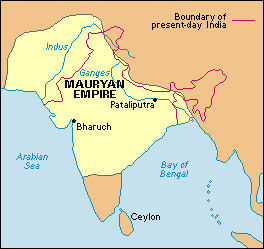Mauryan << MOW ree uhn >> Empire was the first empire to provide a single government for almost all of India. Mauryan emperors ruled from about 324 to about 185 B.C. Their empire centered on Magadha, a rich kingdom in the Ganges Valley.

Chandragupta Maurya ruled from about 324 to about 298 B.C. He conquered much of what is now northern India, Bangladesh, Pakistan, and Afghanistan. His son Bindusara held the throne from about 298 to 272 B.C., and Bindusara’s son Ashoka (also spelled Asoka) governed from about 272 to 232 B.C. Both expanded the empire far into South India. Ashoka eventually gave up further conquest and outlawed war. The empire broke up into smaller units after Ashoka’s death.
During the Mauryan Empire, public irrigation works helped farms produce rich harvests. Craftworkers made cloth, gold, jewelry, and wood products. Many people worked in farms, forests, mines, and workshops owned by the state. Many peasants and war prisoners worked as slaves to develop new agricultural lands. A system of royal inspectors, spies, and informers made sure that officials and citizens alike obeyed the emperor’s will. The Mauryan Empire traded with Greece, Malaya, Mesopotamia, and Persia.
Pataliputra, the Mauryan capital, stood at what is now Patna. It was surrounded by a wall with 570 watchtowers and 64 gates. The brick palace of Chandragupta was in a fenced park filled with flowering trees and shrubs, and lakes. Ashoka built a new palace of stone and also erected many stone monuments with carved inscriptions.
See also Ashoka ; Chandragupta Maurya .
